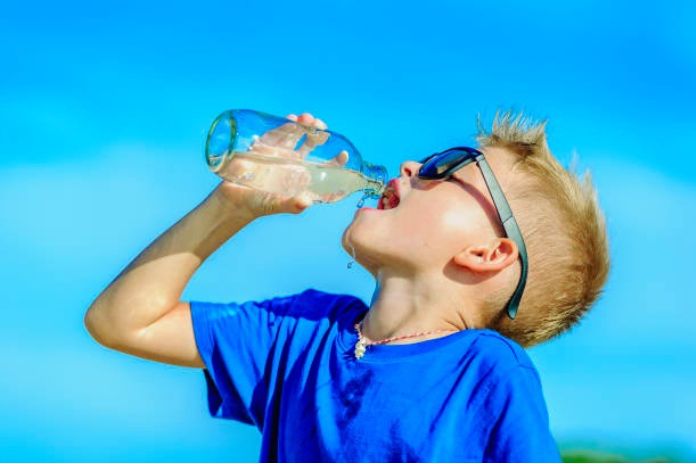How Much Water Do Children Need?
Together with cow’s milk, natural water is the best drink for children: it is healthy because it does not contain empty calories and added sugars, promotes the well-being and development of joints, bones, and teeth, promotes proper blood circulation and helps the children to maintain adequate weight until adulthood. A child’s daily amount of water depends on age, weight, and gender. A child’s air temperature, humidity, physical activity level, and overall health also affect their daily fluid requirement.
How To Choose The Best Water For Children
You must evaluate the fixed residue to guide you in choosing water for your son or daughter. If you use bottled water for your son or daughter, check the label; if you use the tap instead, the simplest thing is to visit the website of the operator that supplies the water, where you can find the value of the fixed residue, the mineral content and the result of the analysis carried out daily. From the list below, you can know the characteristics of water based on its fixed residue:
- Minimally mineralized water (fixed residue less than 50 mg / L): This low residue makes the water particularly suitable for preparing formulated (artificial) milk.
- Water with low mineral content or slightly mineralized water (fixed residue less than 500 mg / L): the low sodium content stimulates diuresis. It makes this water suitable for arterial hypertension in pediatric age.
- Medium mineral water (fixed residue between 500 and 1000 mg / L): the moderate content of mineral salts makes this suitable for all children and therefore represents the best choice.
- Water rich in mineral salts (fixed residue above 1,000 mg / L): it is therapeutic water and, as the name suggests, very rich in mineral salts. However, to avoid an overdose of salts, it is good to buy them and offer them to the child only after receiving the pediatrician’s advice.
What Drinks For Children?
Still, water is undoubtedly the best drink for children and is great for quenching your son or daughter’s thirst. It can be drunk at any time of the day, even with meals. After one year of age, it is good that whole cow’s milk, fresh and pasteurized, is part of the child’s diet, as it is rich in nutrients essential for growth: proteins with high biological value, highly bioavailable calcium, and vitamin D. Calcium, in particular, is a fundamental mineral for the development of bones and teeth and Grana Padano PDO is the cheese that, among the most consumed, provides the most significant quantity, also providing proteins with the nine essential amino acids, essential vitamins such as B2 and B12and antioxidants such as vitamin A, zinc and selenium.
You can use a teaspoon of grated cheese to season first courses or vegetable soups or a few flakes for a savory snack . If there is a family history of obesity or heart disease, low-fat (2%) or low-fat (1%) milk can be considered in place of whole milk if your pediatrician recommends it. Vegetable drinks on the market (commonly but improperly called “milk,” e.g., “milk” of rice, soy, almonds, oats, etc.) are not adequate from a nutritional point of view for children in the first year of life. They should not be given as the primary and only source of “milk” in young children. However, some vegetable drinks with added minerals and vitamins specially formulated for children can be introduced into the diet if the pediatrician recommends them.
From one year of age, children can take no more than half a glass a day of 100% fruit juice, but the advice remains always to prefer fresh fruit (even in the form of unsweetened smoothies or mousses). Remember that fruit juice is deficient in fiber and often contains a lot of added sugars, the excessive consumption of which predisposes children to diseases such as obesity, diabetes, and cardiovascular disorders. Do you want to know how much sugar your son or daughter eats every day and how much they should eat instead? Calculate it quickly and for free here and find out about food replacements with less sugar.
Drinks To Avoid Up To 5 Years Of Age
- Flavored milk (e.g., cocoa, vanilla, caramel, etc.).
- Caffeinated beverages (e.g., cola, soda, coffee, mate, energy drinks, sports drinks). Also, avoid tea, which includes theine, a nervous substance like caffeine. Use chocolate in moderation because cocoa contains theobromine, a substance with a stimulating action on the autonomic nervous system.
- Low-calorie sweetened beverages, e.g ., flavored waters 0 calorie carbonated soft drinks, including those sweetened with stevia, sucralose, or other low-calorie synthetic sweeteners.
How To Increase The Intake Of Water In The Diet
If your little boy or girl doesn’t drink enough water, follow these tips:
- Encourage your son or daughter to start and end the day with a glass of water.
- Always keep water close at hand, in your bag for when you are together, and in your school backpack.
- Infuse water with lemon, berries, cucumber, or mint to make the water more palatable, but don’t add sugar.
- Introduce high-water content vegetables and fruits to your son or daughter’s diet. The vegetables that contain the most water are cucumbers, courgettes, iceberg lettuce, celery, and tomato, while fruit: includes watermelon, melon, strawberries, blueberries, and grapefruit.
- Freeze fresh fruit and use it as an ice cube in a glass of water to make the taste more pleasant.
- Surprise the kids with unique and colorful water bottles or cups. Whether it’s a personalized bottle or an original mug with a spiral straw, adding a touch of cheer can help a lot.
Also Read: Fundamental Roles Of Water And Hydration For The Body

